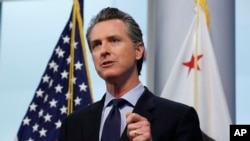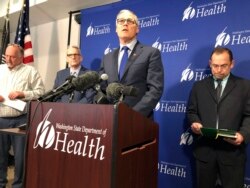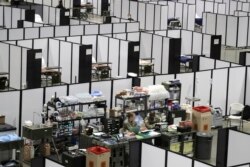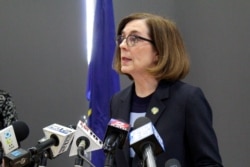With heartening results to show for swift action, the governors of Washington state, Oregon and California on Monday declared a coordinated effort to reopen their states’ economies and form a long-term regional strategy for keeping the coronavirus at bay.
“The West Coast is guided by science,” California Governor Gavin Newsom tweeted. “We issued stay at home orders early to keep the public healthy. We’ll open our economies with that same guiding principle.”
Positive signs of a slowdow
Earlier this month, the region began to see a slowing in the growth rate of the lethal infection. So confident were West Coast leaders in their ventilator supply that they sent more than 1,000 of the life-saving machines back to the national stockpile, to be deployed to harder hit states like New York and Illinois. And a 250-bed field hospital set up in a Seattle sports stadium is to be dismantled and returned to the Federal Emergency Management Agency (FEMA) for use elsewhere.
By no means do Pacific Coast leaders think they’ve defeated the deadly pathogen. But a cautious optimism has emerged that swift actions on social distancing got the region over the hump.
“Huge numbers of people are fulfilling that request and that’s why we’re having some success,” Washington Governor Jay Inslee said at a press briefing.
Governors remain cautious
“But there’s no reason to believe we are done with this. We know we have to have measures of testing and contract tracing and the ability to come out of this in a rational, thoughtful, scientifically-based way,” he added.
“I think it was a triumph in the belief in science here on the West Coast,” said Dr. Amy Compton-Phillips, chief clinical officer for Providence St. Joseph Health, which runs 51 hospitals in Western states. “It takes courage and the belief in numbers and data to act ahead of the curve, and that’s what I think happened here.”
How it began
On Feb. 26, Compton-Phillips' cell phone began to ring nonstop. It was the day health officials discovered the first case of community-based transmission of coronavirus in a woman in Northern California, indicating the coronavirus had been spreading in the region undetected earlier than previously thought.
“As soon as that case became apparent, we knew we were in a pandemic,” Compton-Phillips told VOA.
“We had initially been looking at the growth (of the virus) to double every two to three days,” she said. “But as soon as that community case became apparent, we said ‘Oh my gosh. This is circulating. This is here.’”
Washington state had the first patient in US
A month earlier, a man in Washington state was the first patient in the country to test positive for COVID-19. By mid-March, confirmed cases numbered roughly 1,000, with the West Coast bearing the brunt of cases.
Given widespread inadequate testing capability at the time, many feared the actual number of infections was far higher.
Inslee, the Washington governor, on March 11 instituted a ban on social gatherings of more than 250 people in the Seattle area, a mandate that was the first of its kind in America. Oregon and California followed later that day. The same day, the mayor of San Francisco banned large gatherings of 1,000 people or more.
"The decisions that we're making today and the decisions we probably will be making in the upcoming days are going to be profoundly disturbing to a lot of the ways we live our lives today," Inslee said at a press briefing announcing the ban. "But I believe they are the right ones."
San Francisco first to issue stay-at-home order
On March 16, the West Coast states and six others ordered restaurants and bars to close their dining areas. That day, San Francisco became the first municipality in the nation to order a citywide stay-at-home order. Newsom issued a statewide order three days later.
“That bought us time and helped us bend the curve,” Newsom said, reflecting on his earlier decision in an interview last Wednesday with CNN.
States that waited until the beginning of April to issue stay-at-home orders, such as Texas, Florida and Missouri, are now predicted to experience more coronavirus-related deaths and elevated infection rates for longer periods of time.
For instance, coronavirus deaths in Texas are expected to peak in 16 days, according to projections from the Institute for Health Metrics and Evaluation (IHME). In California, whose population density is significantly higher, the number of fatalities is expected to peak in five days.
West Coast well-equipped for pandemic
An area known for scientific and technological innovation, the West Coast is viewed as better equipped than other areas to deal with a pandemic.
IHME predictions that are being used across the country, from federal to state governments, come from the University of Washington School of Medicine. The Seattle area also enjoys support from the Bill & Melinda Gates Foundation, which has contributed more than $100 million to the global fight against coronavirus, including $5 million to efforts in Seattle.
Silicon Valley’s role
Tech companies in Silicon Valley have increased their capacity to meet growing demand for digital services. And companies such as Microsoft, Twitter, and Intel were among the first major employers to encourage people to work from home. There’s also Google and Apple’s collaboration on a phone-based tracking device meant to interrupt the spread of infection.
Employment policies, too, may have an effect. Washington, Oregon and California are among the few states to offer paid sick leave, an issue Congress tried addressing in a March 26 emergency relief bill requiring companies to provide paid sick leave to coronavirus patients. But the bill covers some businesses and not others. For example: Companies with more than 500 employees are exempt.
“As home to 1 in 6 Americans and gateway to the rest of the world, the West Coast has an outsized stake in controlling and ultimately defeating COVID-19,” reads a joint statement issued Monday by Newsom, Inslee and Oregon Governor Kate Brown. “Health outcomes and science – not politics – will guide these actions.”
Seattle’s rate slowing
While the Seattle area was the first in the nation to experience a coronavirus outbreak, the latest county data shows the rate of infection slowing. On Monday, Seattle’s King County reported 25% fewer new coronavirus cases than the week before.
As of this writing, Oregon has reported a relatively small number of cases of coronavirus – 1,633 confirmed cases and 55 deaths – when compared with its neighbors. California has reported 22,348 confirmed cases and 687 deaths, while Washington state has reported 10,538 confirmed cases and 491 deaths.
Oregon was able to hold down the number of cases because it implemented social distancing measures before seeing a large number of cases, explained Dean Sidelinger, chief epidemiologist for the Oregon Health Authority.
Flattening the curve
“That flattening of the curve – that slowing down the presentation of new cases – is what we think is going to allow our health care system, with the preparations we’ve made, to be able to provide quality healthcare for everyone,” Sidelinger said.
It has been 2½ months since America’s first coronavirus case was detected. Now, the West Coast is leading the nation in showing there can be an end of the tunnel.
“I think there was something about the reality about being hit on the West Coast that made the entire pandemic real,” Compton-Phillips recalled.
“It’s hard to shut down a city and to close schools and put lives on hold to be disrupted for a theoretical threat,” she said. “It helped people understand the gravity of the situation that was.”










